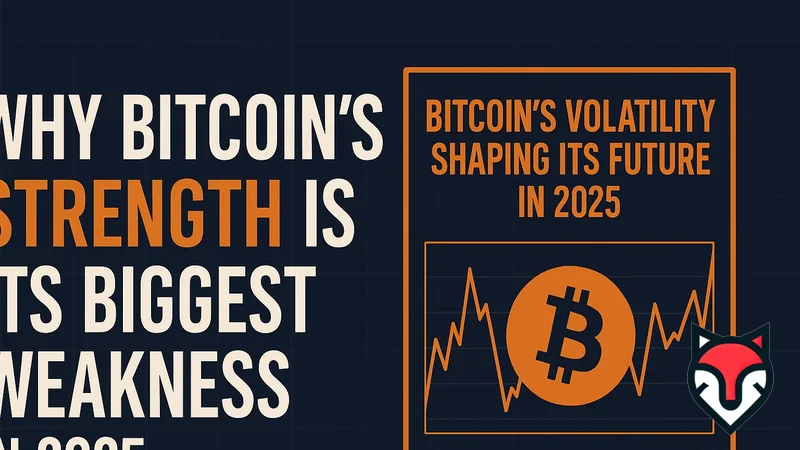Suggested
News
Last updated: Thursday, April 10, 2025

Why Bitcoin’s Strength is Its Biggest Weakness in 2025
It’s April 09, 2025, and Bitcoin remains the king of cryptocurrencies—a decentralized titan born in 2009 that’s defied every skeptic to hit new heights. Its strength lies in its unshakable design: no central authority, a capped supply of 21 million coins, and a blockchain that’s never been hacked. Yet, that same strength fuels its wildest flaw—Bitcoin volatility. In 2025, prices swing like a pendulum, thrilling traders in New York and terrifying vendors in Nairobi. This rollercoaster isn’t just a quirk; it’s the paradox defining Bitcoin’s future. Let’s dive into why Bitcoin’s greatest asset is also its Achilles’ heel—and what it means for you.
The Bedrock of Bitcoin’s Power
Bitcoin’s allure starts with its DNA. Unlike fiat currencies, it’s immune to government meddling—no printing presses, no inflation surprises. Its scarcity mimics gold, with miners racing to unearth the last few million coins by 2140. By 2025, over 19.6 million BTC are in circulation, leaving less than 10% unmined. This rarity drives demand—think of it as digital gold in a world gone crypto-crazy. Add in a network secured by a trillion-dollar hash rate, and you’ve got a fortress. Investors love it: BTC’s market cap tops $1.5 trillion, dwarfing most rivals. That’s strength you can’t fake.
Then there’s the freedom. In Lagos, a freelancer gets paid in BTC, dodging bank fees and currency controls. In Tokyo, a retiree holds it as a hedge against yen devaluation. Decentralization means power to the people—no middleman, no rules but the code. It’s why Bitcoin’s survived crackdowns in China and thrived through bear markets. In 2025, adoption’s soaring—El Salvador’s using it as legal tender, and Tesla’s back to accepting it. This is Bitcoin’s muscle, flexing hard.
The Flip Side: Volatility Unleashed
But here’s the catch: that same strength breeds chaos. Bitcoin’s fixed supply and lack of oversight make it a speculative beast. In January 2025, BTC hit $80,000—by March, it dipped to $55,000. Why? No central bank can step in to stabilize it. A whale sells 10,000 coins, and the market panics. A tweet from a crypto influencer sends it soaring. Bitcoin volatility isn’t a bug—it’s baked into its freedom. In 2025, daily swings of 5-10% are normal, with monthly drops hitting 30%. For traders, it’s a goldmine; for the average user, it’s a heart attack.
Data backs this up. Crypto analytics site CoinGecko logs BTC’s 30-day volatility index at 60%—triple the S&P 500’s. Compare that to Ethereum (45%) or stablecoins like USDT (near 0%). Bitcoin’s price history reads like a thriller: $69,000 in 2021, $16,000 in 2022, back to $70,000 in 2024. In 2025, it’s a magnet for risk-takers—hedge funds bet big, while mom-and-pop investors sweat. That untamed nature? It’s Bitcoin’s superpower—and its kryptonite.

Who Wins, Who Loses?
The volatility splits the world. Wall Street’s quant traders thrive, using AI to ride the waves—firms like Galaxy Digital report 200% returns in Q1 2025. Day traders in Seoul swap memes about “HODLing” through the dips. But merchants? They’re wary. A Hanoi cafe accepting BTC might earn $100 one day, $70 the next—hardly a stable business model. In Buenos Aires, a landlord ditches BTC rent payments after a 20% crash burns his budget. Bitcoin’s strength draws the bold, but its swings scare off the cautious.
Even big players feel the heat. MicroStrategy, with its $10 billion BTC stash, sees its stock mirror Bitcoin’s rollercoaster. When BTC dips, their balance sheet bleeds—yet they double down, betting on the long game. Meanwhile, stablecoin rivals like Tether gain ground, offering calm waters for DeFi users who can’t stomach BTC’s storms. Bitcoin’s dominance—50% of crypto’s market—wobbles as volatility pushes some to safer shores.
Real Life in Bitcoin’s Wild Ride
Zoom into daily life, and the paradox sharpens. In San Francisco, a techie buys a Tesla with BTC, grinning as the price spikes mid-transaction. In rural India, a farmer cashes out BTC aid from a charity—only to lose 15% overnight. Volatility shapes stories: a Bangkok artist sells an NFT for 2 BTC, then watches it halve in value before she spends it. In 2025, Bitcoin’s a gamble even when it works. Its strength—uncontrolled, unbowed—means you’re free, but never safe.
Adoption’s growing, but with asterisks. A Miami bar takes BTC, but converts it to dollars instantly. A Kenyan solar firm uses it for cross-border deals, hedging with futures. People want Bitcoin’s promise—security, autonomy—but flinch at its chaos. Surveys show 60% of new users cite volatility as their top worry, per Chainalysis. It’s a love-hate dance: the same tech that liberates you can leave you broke.
The Techies and Titans Behind It
Who’s steering this ship? Satoshi Nakamoto’s ghost still looms—Bitcoin’s creator left a system so robust it runs itself. Miners, from Texas rigs to Iceland’s geothermal hubs, keep it humming, burning $15 billion in energy yearly. Devs like Pieter Wuille tweak the code, adding tricks like Taproot to boost efficiency. In 2025, figures like Brian Armstrong of Coinbase push BTC to the masses, while critics like Nouriel Roubini call it a “speculative bubble.” They’re all right, in a way—Bitcoin’s strength and weakness are two sides of the same coin.
What’s Next for Bitcoin Volatility?
By December 2025, expect more fireworks. Analysts at Glassnode predict BTC could hit $100,000—or crash to $40,000—depending on ETF flows and China’s next crypto stance. Regulators hover: the U.S. mulls stricter rules, while Singapore opens its arms. Tech upgrades like Lightning Network aim to tame fees and speed, but not the price swings. Some say volatility will fade as adoption grows—others argue it’s Bitcoin’s lifeblood. Check CoinGecko or Glassnode for the latest pulse—it’s a saga unfolding live.
DeFi’s a wildcard. If Bitcoin integrates tighter with lending platforms, volatility could spike as leverage amplifies swings. Or, if central banks launch digital currencies (CBDCs), BTC’s edge might dull—though its diehards won’t budge. One thing’s sure: Bitcoin’s strength won’t vanish, and neither will its chaos.
Why It Matters to You
Bitcoin in 2025 isn’t just for crypto bros—it’s a mirror. Its strength reflects a world craving freedom from old systems; its volatility warns of the cost. Searching “Bitcoin volatility 2025” or “BTC future trends”? You’re here for it. Maybe you’re a trader eyeing the next dip, or a skeptic waiting for the fall. Either way, Bitcoin’s paradox hooks you: a rock-solid dream that’s shaky as hell. So, where do you stand—riding the wave, or watching it crash?
Suggested Articles
For You
Related Articles
- Crypto Index Funds: The Future of Decentralized Crypto Investing
- DeFi Yield ETFs: Unlocking High Returns in Decentralized Finance
- Homomorphic Encryption - Applications in Blockchain
- DeFi's Evolution: Key Trends Shaping Decentralized Finance in 2025
- What If Bitcoin Fails—Who Wins in a Post-BTC World?
- How Bitcoin ETFs Rewrote the Rules of Wall Street
- Is Bitcoin Still a Hedge Against Inflation—or Just Hype?
- The Halving Myth—Why It Might Not Matter Anymore
- Can Bitcoin Survive a Cashless America? Exploring Bitcoin Adoption in a Digital Era
- How Trump’s Policies Could Turbocharge Bitcoin in 2025: A Political Power Play












